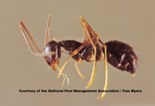Need assistance? Call 800.996.4402
Menu
Need assistance? Call 800.996.4402

Crazy ants get their common name from the workers’ habit of running in an erratic, jerky manner when searching for food.
Crazy ants feed primarily on live and dead insects, seeds, fruits and honeydew. They are found throughout the U.S., but are confined to the indoors in the northern states because they cannot survive the winter outdoors. Caribbean crazy ants enter homes in the autumn or after rainfall because both conditions reduce their supply of honeydew.
Caribbean crazy ants do not pose a health threat, but if they gain entry to a structure, they can become a nuisance.
Crazy ants feed primarily on live and dead insects, seeds, fruits and honeydew. They are found throughout the U.S., but are confined to the indoors in the northern states because they cannot survive the winter outdoors. Caribbean crazy ants enter homes in the autumn or after rainfall because both conditions reduce their supply of honeydew.
To prevent Caribbean crazy ants, it is important to seal all possible points of entry around the house including small openings and cracks around doors and windows. Trim vegetation away from the home to prevent pathways inside. Food spills and other potential attractants should be cleaned up as soon as possible to avoid attracting crazy ants.






For the very best food safety consulting, auditing and training, please visit our strategic partner, CFS Food Safety